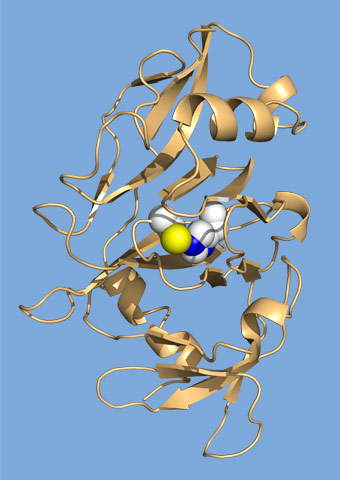- Home
- News
- General News
- Scientists defuse...
Scientists defuse the Vietnam time bomb
10-11-2011
A key mechanism by which a bacterial pathogen causes the deadly tropical disease melioidosis has been discovered by an international team of scientists.
Share
This news item is published jointly by University of Sheffield, Diamond Light Source and the ESRF.
The findings are published today in the journal Science and show how a toxin produced by the bacterium Burkholderia pseudomallei kills cells by preventing protein synthesis. The study, led by the University of Sheffield, paves the way for the development of novel therapies to combat the bacterium which infects millions of people across South East Asia and Northern Australia.
Using intense X-rays at Diamond Light Source (UK) and at the ESRF, the research team solved the structure of a protein, BPSL1549, from Burkholderia pseudomallei, the function of which was initially unknown.
“The information gathered from the structure suggested that the protein was a previously unsuspected toxin and sparked a search for its mode of action. This eventually led to the discovery of how it prevents human cells from making proteins and helped us to understand how it causes cell death,” says research lead Professor David Rice from the Department of Molecular Biology and Biotechnology at the University of Sheffield.
The researchers found that the structure of BPSL1549 had a strong structural resemblance to an E. coli toxin called cytotoxic necrotizing factor 1 (CNF1). Further investigations showed that BPSL1549 is itself a powerful toxin that inhibits protein translation in eukaryotic cells by deamidation of a vital glutamine residue in the translation initiation factor eIF4A. By preventing cells from manufacturing proteins, the toxin causes cell death. For this reason the protein was given the new name Burkholderia Lethal factor 1.
Melioidosis, along with HIV and tuberculosis, is one of the top three causes of death by infectious disease in parts of South East Asia and arises from infection by the bacterium which thrives in water and warm, moist soils and can enter the body through the lungs or through open wounds.
It causes either an acute form of the disease which presents immediately upon infection, or it can lay dormant in the body emerging many years, and often decades, later. In the acute form of the disease, even with a long course of treatment, mortality rates in endemic areas can be as high as 40 per cent. With a wide range of symptoms, melioidosis can be difficult to diagnose, hampering medical intervention.
“This disease is an everyday reality for many people living in the endemic areas and our findings will allow us to test if an inactivated toxin might be effective as a component of a vaccine,” says Professor Rick Titball, a member of the team from the University of Exeter.
The delayed action of the bacteria has led to it being dubbed the ‘Vietnam time bomb’ following the recognition that many US military personnel who served in Vietnam have been infected. “Now that we know of the existence of this toxin it opens up opportunities for the development of novel drugs that could block its effects,” says University of Sheffield Professor, Stuart Wilson.
The study involved a consortium of UK scientists from the University of Sheffield, the University of Exeter, Diamond Light Source and the Defence Science and Technology Laboratory at Porton Down. European and international partners included: the ESRF; Universiti Kebangsaan Malaysia; the Malaysia Genome Institute; DSO National Laboratories, Singapore, and the Genome Institute of Singapore.
Kevin van Cauter, HE Advisor with the British Council commented “We are thrilled that PMI2 funding supported this international collaboration and are excited by the potential impact of the work.”
These groups now plan to seek funding to continue the work and investigate potential applications of the toxin to fight other diseases, such as cancer, where it might usefully be employed in targeted therapies to prevent the proliferation of cancer cells.
Reference
A Burkholderia pseudomallei toxin inhibits helicase activity of translation factor eIF4A, A. Cruz-Migoni, G.M. Hautbergue, P.J. Artymiuk, P.J. Baker, M. Bokori-Brown, C.-T. Chang, M.J. Dickman, A. Essex-Lopresti, S.V. Harding, N. Muhammad Mahadi, L.E. Marshall, G.W. Mobbs, R. Mohamed, S. Nathan, S.A. Ngugi, C. Ong, W. Fong Ooi, L.J. Partridge, H.L. Phillips, M. Firdaus Raih, S. Ruzhenikov, M. Sarkar-Tyson, S.E. Sedelnikova, S.J. Smither, P. Tan, R.W. Titball, S.A. Wilson, D.W. Rice, Science 334, 821-824 (2011).
Top image: A scene from the Vietnam war by photographer Tim Page (used with permission). The disease meliodosis was caught by soldiers following contact with damp soil and stagnant water. Superposed on the photo is the structure of Burkholderia lethal factor 1.




